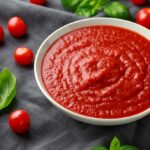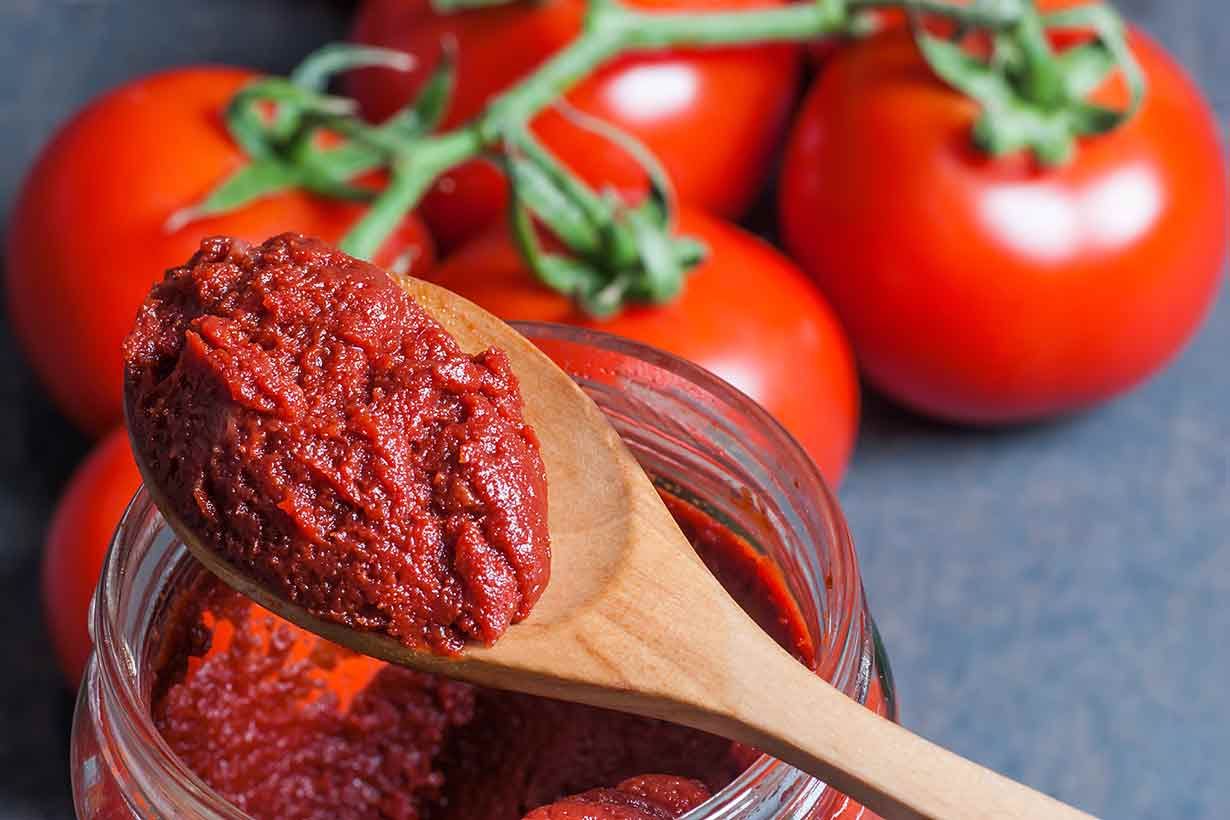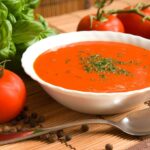Tomatoes are botanically a fruit, but people tend to use them as a vegetable for culinary purposes.
Aside from whole tomatoes, numerous tomato products are available, all with their own taste, texture, usage, and nutritional properties.
This article examines the most common tomato products and what they offer nutritionally.
Table of contents
Types of Tomato Products
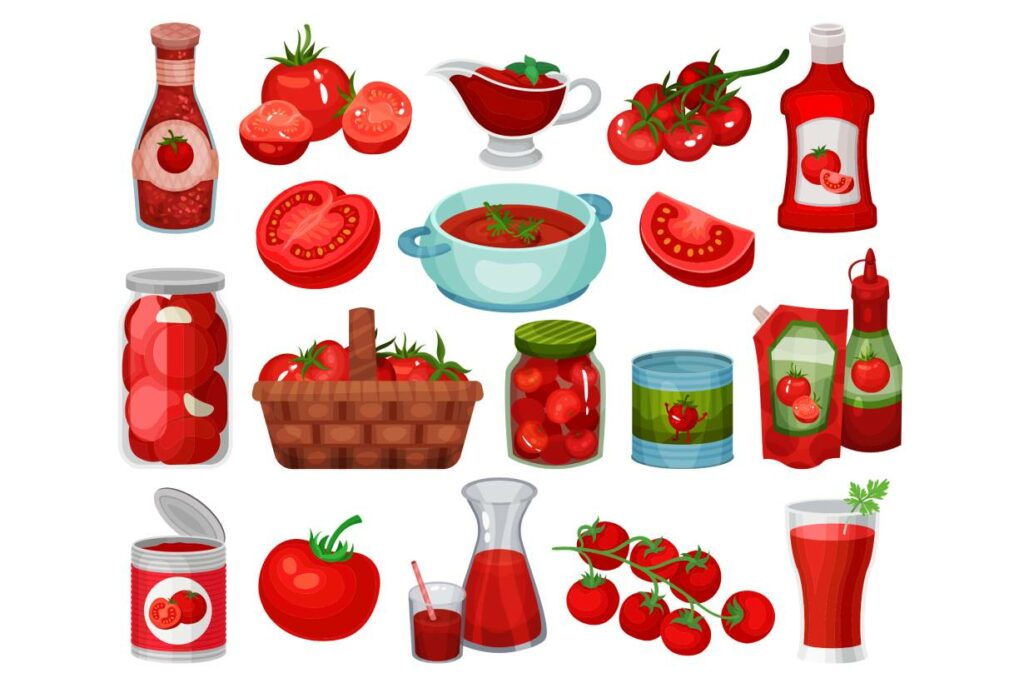
Tomato products differ in taste, texture, and nutritional properties.
In this regard, the key determinant of these differences is how the product has been processed.
Some tomato products are cooked, some are pureed, some are chopped, and others are mixed with other ingredients.
This section examines twelve common types of tomato products, their properties, and their nutritional values.
Unless otherwise stated, the USDA’s FoodData Central database is the source of all nutritional data (1).
1) Capuliato
Capuliato is an interesting tomato product that originated on the Italian island of Sicily.
To make capuliato, sun-dried tomatoes are chopped or minced into small pieces and then placed in a marinade. This marinade is typically made from extra virgin olive oil, salt, chili pepper, and herbs such as basil, rosemary, and oregano.
The finished condiment is thick and flavorful and can be used in numerous ways.
For example, capuliato can be spread on bread, used as a pizza topping, or mixed into stews.
It can also be a baste for meat, fish, and other firm proteins (such as extra firm tofu) or used as a side.
Using data from My Fitness Pal, here are the nutritional values for 100 grams of capuliato (2):
- Calories: 247 kcal
- Carbohydrates: 23.0 g
- Fat: 15.0 g
- Protein: 5.0 g
- Sodium: 2300 mg
2) Chopped Tomatoes
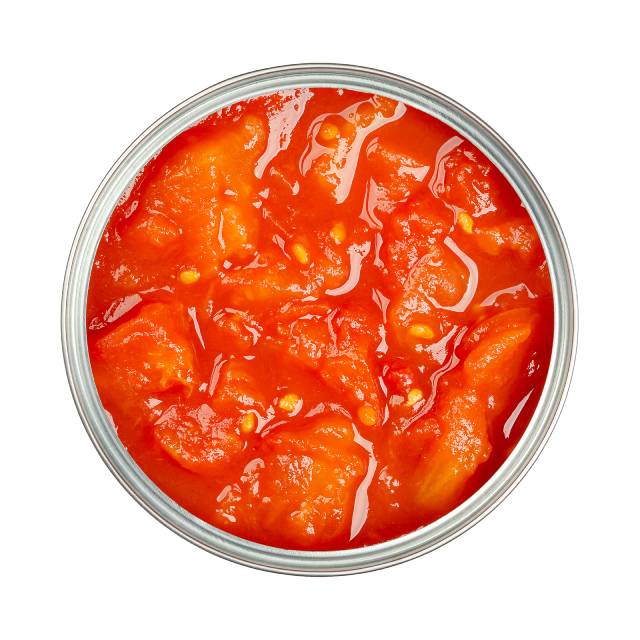
Chopped tomatoes are a very simple product.
Firstly, after fulfilling the selection criteria (red tomatoes with firm skin), the tomatoes are cleansed and then heated in water. This makes the skins soften, which are subsequently removed by a machine.
After this, the tomatoes flow into a dicer machine where they are chopped into small uniform pieces. The tomatoes are then canned, and sometimes additional ingredients like tomato juice and flavorings (like basil) are added.
Lastly, the canned tomatoes are cooked, which removes the need for preservatives, although salt may sometimes be added.
This video from the Discovery Channel shows the process in full for a more visual guide.
Per 100 grams, chopped tomatoes have the following nutritional values (3):
- Calories: 22 kcal
- Carbohydrates: 4.8 g
- Fiber: 1.6 g
- Sugars: 3.2 g
- Fat: 0 g
- Protein: 0.8 g
- Sodium: 4 mg
Chopped tomatoes are a good base for curries, sauces, soups, and stews.
3) Ketchup
Ketchup is one of the most popular condiments in the world, and it is a staple in most kitchens.
However, it is one of the most processed tomato products and contains significant amounts of added sugar and salt.
Contrary to popular opinion, and perhaps surprisingly, it is likely that China was the origin of what we know now as ‘ketchup’ (4).
The production process of ketchup is relatively straightforward and involves mixing tomato paste with vinegar, sugar, salt, herbs, and spices.
100 grams of ketchup typically provides the following nutrients (5):
- Calories: 109 kcal
- Carbohydrates: 27.1 g
- Fiber: 0.3 g
- Sugars: 21.5 g
- Fat: 0.32 g
- Protein: 1.08 g
- Sodium: 928 mg
As we can see, it has a high sugar and sodium content.
4) Salsa
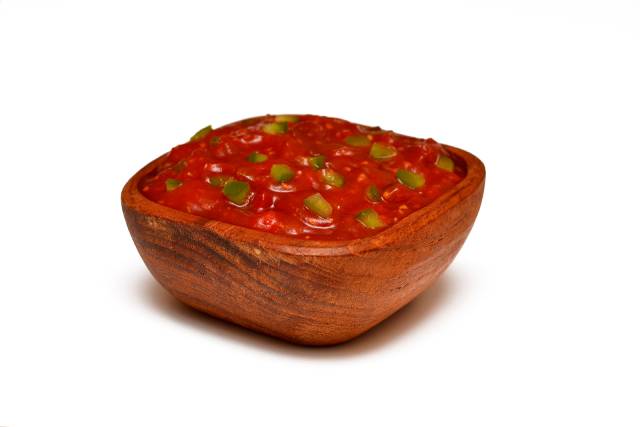
Salsa is a delicious and flavorful condiment often used as a dip or sometimes as a side dish.
The primary ingredient in salsa is tomatoes, but it also contains a variety of other vegetables, herbs, and spices. For instance, onions, bell peppers, and garlic often feature in a salsa recipe.
Generally speaking, most salsa can be categorized as a spicy tomato sauce with a heat rating ranging from mild to hot.
Mexico is the birthplace of salsa, where salsa-style sauces have been consumed for hundreds of years (6).
Salsa contains a variety of nutrient-rich ingredients. However, one downside is that it can also be high in sodium.
A typical salsa product offers the following nutritional values on a 100-gram basis (7):
- Calories: 29 kcal
- Carbohydrates: 6.64 g
- Fiber: 1.9 g
- Sugars: 4.01 g
- Fat: 0.17 g
- Protein: 1.52 g
- Sodium: 711 mg
For more information, see this guide to salsa’s benefits, downsides, and uses.
5) Sun-dried Tomatoes
Sun-dried tomatoes are a flavorful product traditionally made by letting fresh tomatoes dry out under the sun.
However, they can also be made in commercial ovens and dehydrators or even at home using a dehydrator (disclosure: affiliate link).
Compared to regular tomatoes, they have a fuller flavor and a much stronger tomato taste.
This is because the tomatoes lose their water content during the drying process, so the remaining tomato has a more concentrated flavor.
Nutritionally, sun-dried tomatoes contain more calories and carbohydrates than fresh tomatoes.
Once again, this is because of the lower water content. Also, sometimes sun-dried tomatoes are packed in oil, which will also increase their fat content.
Sun-dried tomatoes are very popular in the Mediterranean region and work well in salads, pasta dishes, and stews.
Per 100 grams, sun-dried tomatoes typically provide the following nutritional values (8):
- Calories: 258 kcal
- Carbohydrates: 55.8 g
- Fiber: 12.3 g
- Sugars: 37.6 g
- Fat: 2.97 g
- Protein: 14.1 g
- Sodium: 107 mg
6) Tomato Chutney
Chutney originated in India and comes in many different varieties; it is often a sweet and spicy condiment (9).
Chutneys are made from numerous different fruit and vegetables, including tomatoes.
Making tomato chutney typically involves simmering tomatoes and sugar alongside herbs and spices like garlic, ginger, and chili pepper. Oil may also be used as part of the cooking process, but this will vary by product.
The finished product is a sweet, spicy condiment mainly used as a dip. However, it could also be used as a filling or even mixed into salads for flavoring.
Here are the nutritional values of a commercial tomato chutney per 100 grams (10):
- Calories: 218 kcal
- Carbohydrates: 48.5 g
- Fiber: 1.8 g
- Sugars: 42.4 g
- Fat: 6.06 g
- Protein: 0 g
- Sodium: 667 mg
As shown in the nutritional values, tomato chutney can be quite salty and has a high sodium content.
7) Tomato Jam
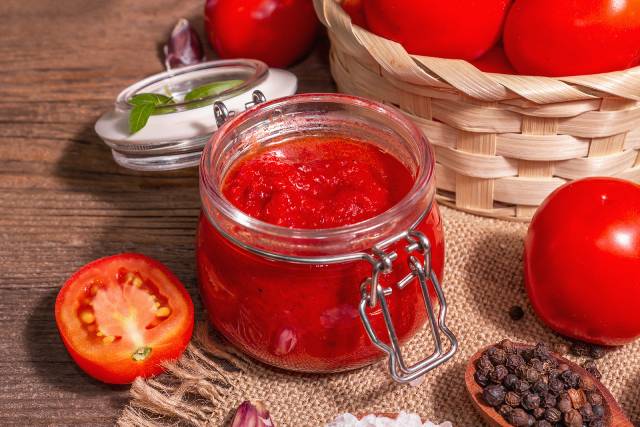
Most people think of berries when they hear the word “jam.” After all, strawberry and raspberry jam are very common.
However, many different fruits and vegetables can be used to make jam, and tomatoes are no exception.
Unlike other jams, tomato jam is typically considered a savory spread used as a filling in sandwiches.
It does not have the vinegar content of ketchup or chutney, and it has a much sweeter taste due to its high sugar content.
Tomato jam’s ingredients include whole chopped tomatoes, sugar, salt, herbs, and spices. There is a recipe showing how to make it here.
The typical nutritional content of tomato jam per 100 grams is as follows (11):
- Calories: 225 kcal
- Carbohydrates: 55.0 g
- Fiber: 0 g
- Sugars: 55.0 g
- Fat: 0 g
- Protein: 0 g
- Sodium: 175 mg
8) Tomato Juice
It isn’t as popular as apple or orange juice, but it is a common tomato product.
Since tomatoes are naturally lower in sugar than fruits like oranges, tomato juice does not have the sweetness many juices offer.
Rather than being sweet, tomato juice has a slightly sweet and sour taste. The liquid is primarily one ingredient: tomatoes, but some products add a small amount of salt.
Production is simple and involves cooking tomatoes until they soften, straining out the seeds and skins, and bottling the juice (12).
Per 100 grams, tomato juice has the following nutrition profile (13):
- Calories: 23 kcal
- Carbohydrates: 4.32 g
- Fiber: 0.4 g
- Sugars: 2.57 g
- Fat: 0.29 g
- Protein: 0.86 g
- Sodium: 236 mg
See this comprehensive guide to tomato juice for more information:
The Nutritional Benefits of Tomato Juice
9) Tomato Passata (Puree)
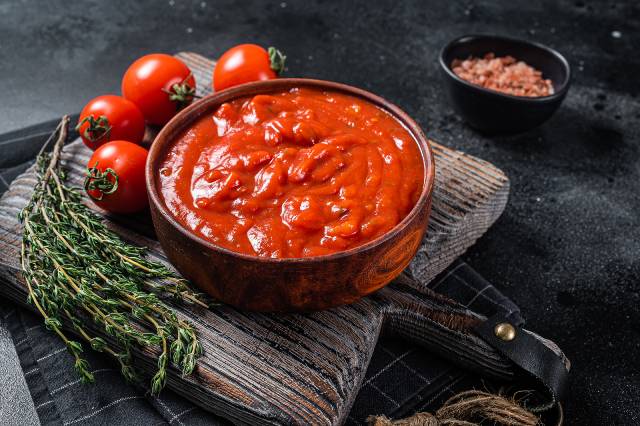
Tomato passata and tomato puree are two different products that are very similar.
In this regard, both of these tomato products are pureed tomatoes.
However, passata is traditionally uncooked, whereas products labeled ‘tomato puree’ tend to have been cooked before packaging.
These products have many uses but are typically used as a base for a sauce, curry, soup, or stew.
This complete nutritional guide to tomato passata provides much more information on the product’s benefits, downsides, and uses.
A typical tomato puree provides the following nutrients per 100 grams (14):
- Calories: 38 kcal
- Carbohydrates: 8.98 g
- Fiber: 1.9 g
- Sugars: 4.83 g
- Fat: 0.21 g
- Protein: 1.65 g
- Sodium: 28 mg
10) Tomato Paste
Unlike most tomato products, tomato paste is exceptionally thick and concentrated.
Rather than being consumed how it is, the paste is usually added to dishes for flavoring purposes.
For instance, it can be:
- An ingredient in a dip
- Mixed into soups and stews
- Part of a marinade for meat/fish/tofu
Tomato paste gets its thick texture from an evaporation process during its production to remove significant amounts of its water content.
This complete guide to tomato paste provides more information on the product’s characteristics and nutritional benefits.
Here are the nutritional values for 100 grams of tomato paste (15):
- Calories: 106 kcal
- Carbohydrates: 21.2 g
- Fiber: 6.1 g
- Sugars: 12.1 g
- Fat: 0 g
- Protein: 3.03 g
- Sodium: 258 mg
11) Tomato Sauces
In truth, there is no single “tomato sauce,” and the nutritional values of these products can vary significantly.
However, compared to similar products like passata and puree, tomato sauces have a more liquid consistency.
Furthermore, they tend to contain a wide range of additional ingredients that may or may not include salt, sugar, oil, herbs, and spices.
Some famous tomato sauce products include bolognese and marinara, Italian sauces used in pasta dishes. Also, there are many tomato-based curry sauces with spiciness ratings ranging from mild to very hot.
A typical marinara sauce offers the following nutritional values per 100 grams (16):
- Calories: 50 kcal
- Carbohydrates: 7.43 g
- Fiber: 1.8 g
- Sugars: 4.91 g
- Fat: 1.61 g
- Protein: 1.39 g
- Sodium: 437 mg
12) Tomato Soup
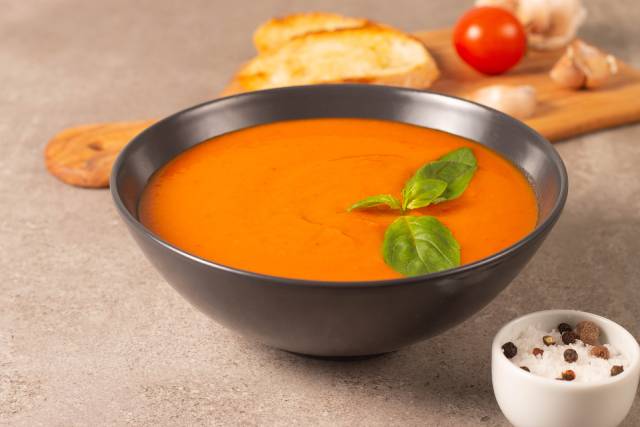
Tomato soup is a classic traditional tomato product that is often considered “comforting” food.
The traditional recipe for tomato soup calls for tomatoes mixed with cream, salt, and sometimes some other vegetables.
Although people usually consume tomato soup alone, it can also form a base for different sauce and soup/stew recipes.
Campbell’s tomato soup, which is arguably the most famous processed tomato soup, contains the following nutrients per 100 grams (17):
- Calories: 71 kcal
- Carbohydrates: 15.2 g
- Fiber: 1.1 g
- Sugars: 8.23 g
- Fat: 0.44 g
- Protein: 1.46 g
- Sodium: 377 mg
For a complete guide to the nutritional pros and cons of tomato soup, please refer to the following guide:
Is Tomato Soup Good For You? It Depends
Pros and Cons of Processed Tomato Products
This article shows that tomato products can vary significantly in nutritional value.
However, there are some shared characteristics that they tend to offer, which can be both positive and negative.
Here is a quick summary of these potential pros and cons:
- Tomato products offer significant amounts of lycopene, a type of carotenoid. Tomatoes are the best dietary source of lycopene. However, lycopene isn’t as bioavailable in whole tomatoes as the cell walls of the tomato limit how much we can absorb. In contrast, processed tomato products (and the cooking process) make lycopene more bioavailable. Lycopene is thought to have a wide range of potential health benefits (18, 19, 20).
- Since tomatoes are a good dietary source of fiber and vitamin C, products containing whole tomatoes will also provide these nutrients (21).
- One potential negative point about tomato products is the additional ingredients they can contain. For example, some products can be high in salt, sugar, and oil (as well as calories). If this is an issue, lesser-processed products like passata and tomato paste are primarily tomato with little else added.
Frequently Asked Questions
For further information, here are some answers to common questions about tomato products.
This will depend on the specific product and how it has been stored. For example, keeping tomato paste or ketchup in the refrigerator will give it a longer shelf-life than in a cupboard. The packaging of each tomato product should provide helpful information on when it should be consumed and storage instructions.
Some can, but not all will be suitable for freezing. Once again, the label should provide information on a product’s suitability for freezing. Tip: filling ice cube trays with tomato paste is a great way to save leftover paste for use in the future. These frozen tomato paste cubes can be easily added to dishes in the desired quantity.
Some products contain preservatives, but many don’t. Therefore, checking the ingredients label to see what a given product contains is important. Products with a wide range of ingredients (like pasta sauces) are more likely to include additional ingredients like thickeners or preservatives.
Final Thoughts
We should probably limit some processed foods in our diet, but processed foods should be judged on their individual merits.
In this regard, several nutrient-rich tomato products can simultaneously improve the taste of our food and our nutrient intake.

